Short- and Long-Term Effects of Lime and Gypsum Applications on Acid Soils in a Water-Limited Environment: 3. Soil Solution Chemistry
Abstract
1. Introduction
2. Materials and Methods
2.1. Field Experimental Sites
2.2. Soil Measurements
2.3. Ionic Strength
2.4. Aluminum Species
2.5. Statistical Analysis
3. Results
3.1. Soil Solution Measurement
3.2. Soil Relationships with Solution Properties
3.3. Soil Solution Al Species
4. Discussion
5. Conclusions
Author Contributions
Funding
Institutional Review Board Statement
Informed Consent Statement
Data Availability Statement
Acknowledgments
Conflicts of Interest
References
- Anderson, G.C.; Bell, R.W. Wheat grain-yield response to lime application: Relationships with soil pH and aluminium in Western Australia. Crop Pasture Sci. 2019, 70, 295–305. [Google Scholar] [CrossRef]
- Sumner, M.E. Gypsum as an Ameliorant for the Subsoil Acidity Syndrome; Florida Institute of Phosphate Research: Bartow, FL, USA, 1990. [Google Scholar]
- McLay, C.D.A.; Ritchie, G.S.P.; Porter, W.M.; Cruse, A. Amelioration of subsurface acidity in sandy soils in low rainfall regions. 1. Responses of wheat and lupins to surface-applied gypsum and lime. Aust. J. Soil Res. 1994, 32, 835–846. [Google Scholar] [CrossRef]
- Tang, C.; Rengel, Z.; Abrecht, D.; Tennant, D. Aluminium–tolerant wheat uses more water and yields than aluminium–sensitive one on a sandy soil with subsurface acidity. Field Crops Res. 2002, 78, 93–103. [Google Scholar] [CrossRef]
- Anderson, G.C.; Pathan, S.; Easton, J.; Hall, D.J.M.; Sharma, R. Short and long term effects of lime and gypsum application on acid soils in a water-limited environment: 1. Grain yield response and nutrient concentration. Agronomy 2020, 10, 1213. [Google Scholar] [CrossRef]
- Anderson, G.C. Sulfate sorption as measured by a buffering index over a range of soil properties from south Western Australia. Soil Res. 2020, 58, 651–661. [Google Scholar] [CrossRef]
- Anderson, G.C.; Fillery, I.R.P.; Ripper, F.H.; Leach, B.J. Sulfur mineralization in a coarse-textured soil after different sulfate fertilization histories and yield responses of wheat and lupin. Aust. J. Soil Res. 2006, 44, 165–174. [Google Scholar] [CrossRef]
- Anderson, G.C.; Pathan, S.; Easton, J.; Hall, D.J.M.; Sharma, R. Short and long term effects of lime and gypsum application on acid soils in a water-limited environment: 2. Soil chemical properties. Agronomy 2020, 10, 1987. [Google Scholar] [CrossRef]
- Li, G.D.; Conyers, M.K.; Helyar, K.R.; Lisle, C.J.; Poile, G.J.; Cullis, B.R. Long-term surface application of lime ameliorates subsurface soil acidity in the mixed farming zone of south-eastern Australia. Geoderma 2019, 338, 236–246. [Google Scholar] [CrossRef]
- Nye, P.H.; Ameloko, A.Y. Predicting the rate of dissolution of lime in soils. J. Soil Sci. 1987, 38, 641–644. [Google Scholar] [CrossRef]
- Whitten, M.G.; Wong, M.T.F.; Rate, A.W. Amelioration of subsurface acidity in the south-west of Western Australia: Downward movement and mass balance of surface–incorporated lime after 2–15 years. Aust. J. Soil Res. 2000, 38, 711–728. [Google Scholar] [CrossRef]
- Lebedev, A.L.; Kosorukov, V.L. Gypsum solubility in water at 25 °C. Geochem. Internat. 2017, 55, 205–210. [Google Scholar] [CrossRef]
- Aylward, G.H.; Findlay, T.J.V. SI Chemical Data Book, 7th ed.; John Wiley & Sons Australia: Milton, NSW, Australia, 2013; ISBN 978-0-730-30246-9. [Google Scholar]
- McLay, C.D.A.; Ritchie, G.S.P.; Porter, W.M.; Cruse, A. Amelioration of subsurface acidity in sandy soils in low rainfall regions. 2. Changes to soil solution composition following the surface application of gypsum and lime. Aust. J. Soil Res. 1994, 32, 847–865. [Google Scholar] [CrossRef]
- Zoca, S.M.; Penn, C. An important tool with no instruction manual: A review of gypsum use in agriculture. Adv. Agron. 2017, 144, 1–44. [Google Scholar] [CrossRef]
- Alva, A.K.; Sumner, E.M.; Noble, A.D. Alleviation of aluminium toxicity by phospho–gypsum. Commun. Soil Sci. Plant Anal. 1988, 19, 385–403. [Google Scholar] [CrossRef]
- Mora, M.L.; Schnettler, B.; Demanet, R. Effect of liming and gypsum on soil chemistry, yield, and mineral composition of ryegrass grown in an acidic Andisol. Commun. Soil Sci. Plant Anal. 1999, 30, 9–10. [Google Scholar] [CrossRef]
- Menzies, N.W.; Bell, L.C.; Edwards, D.G. Exchange and solution phase chemistry of acid, highly weathered soils. I. Characteristics of soils and the effects of lime and gypsum amendments. Aust. J. Soil Res. 1994, 32, 251–267. [Google Scholar] [CrossRef]
- Curtin, D.; Syers, J.K. Mechanism of sulphate adsorption by two tropical Soils. J. Soil Sci. 1990, 41, 295–304. [Google Scholar] [CrossRef]
- Uehara, G.; Gillman, G.P. The Mineralogy, Chemistry, and Physics of Tropical Soils with Variable Charge Clays; Westview Press: Boulder, CO, USA, 1981. [Google Scholar]
- Kinraide, T.B. Identity of the rhizotoxic aluminium species. Plant Soil 1991, 134, 167–178. [Google Scholar] [CrossRef]
- Gensemer, R.W.; Playle, R.C. The bioavailability and toxicity of Aluminum in aquatic environments. Crit. Rev. Environ. Sci. Technol. 1999, 29, 315–450. [Google Scholar] [CrossRef]
- Singh, S.; Tripathi, D.K.; Singh, S.; Sharma, S.; Dubey, N.K.; Chauhan, D.K.; Vaculík, M. Toxicity of aluminium on various levels of plant cells and organism: A review. Environ. Exp. Bot. 2017, 137, 177–193. [Google Scholar] [CrossRef]
- Gustafsson, J.P.; Belyazid, S.; McGivney, E.; Löfgren, S. Aluminium and base cation chemistry in dynamic acidification models—Need for a reappraisal? Soil 2018, 4, 237–250. [Google Scholar] [CrossRef]
- Gustafsson, J.P. Visual MINTEQ 3.1 User Guide. 2019. Available online: https://vminteq.lwr.kth.se/download/ (accessed on 11 January 2019).
- Ritchie, G.S.P. Soluble Aluminium in Acidic Soils: Principles and Practicalities. In Plant Soil Interactions at Low pH; Date, R.A., Grundon, N.J., Rayment, G.E., Probert, M.E., Eds.; Kluwer Academic Publishers: Dordrecht, The Netherlands, 1995; pp. 23–33. [Google Scholar]
- Lindsay, W.L. Chemical Equilibria in Soils; John Wiley and Sons, Inc.: New York, NY, USA, 1979. [Google Scholar]
- Wright, R.J.; Baligar, V.C.; Ritchey, K.D.; Wright, S.F. Influence of soil solution aluminum on root elongation of wheat seedlings. Plant Soil 1989, 113, 294–298. [Google Scholar] [CrossRef]
- Rutkowska, B.; Szulc, W.; Hoch, M.; Spychaj–Fabisiak, E. Forms of Al in soil and soil solution in a long–term fertilizer application experiment. Soil Use Manag. 2015, 31, 114–120. [Google Scholar] [CrossRef]
- Bruce, R.C.; Warrell, L.A.; Edward, D.G.; Bell, L.C. Effects of aluminium and calcium in the soil solution of acid soils on root elongation of Glycine max cv. Forrest. Aust. J. Agric. Res. 1988, 38, 319–338. [Google Scholar] [CrossRef]
- Cameron, R.C.; Ritchie, G.S.P.; Robson, A.D. Relative toxicities of inorganic aluminum complexes to barley. Soil Sci. Soc. Am. J. 1986, 50, 1231–1236. [Google Scholar] [CrossRef]
- Povar, I.; Spinu, O. The role of hydroxy aluminium sulfate minerals in controlling Al3+ concentration and speciation in acidic soils. Cent. Eur. J. Chem. 2014, 12, 877–885. [Google Scholar] [CrossRef]
- Drábek, O.; Kipkoech Kiplagat, L.; Komárek, M.; Tejnecký, V.; Borůvka, L. Study of interactions between relevant organic acids and aluminium in model solutions using HPLC and IC. Soil Water Res. 2015, 10, 172–180. [Google Scholar] [CrossRef]
- Miotto, A.; Tiecher, T.; Kaminski, J.; Brunetto, G.; De Conti, L.; Tiecher, T.L. Soil acidity and aluminum speciation affected by liming in the conversion of a natural pasture from the Brazilian Campos Biome into no-tillage system for grain production. Arch. Agron. Soil Sci. 2019. [Google Scholar] [CrossRef]
- Tipping, E.; Woof, C.; Backes, C.A.; Ohnstad, M. Aluminium speciation in acidic natural waters: Testing of a model for Al-humic complexation. Water Res. 1988, 22, 321–326. [Google Scholar] [CrossRef]
- Mitrovic, B.; Milacic, R. Speciation of aluminium in forest soil extracts by size exclusion chromatography with UV and ICP-AES detection and cation exchange fast protein liquid chromatography with ETAAS detection. Sci. Total Environ. 2000, 258, 183–194. [Google Scholar] [CrossRef]
- Adams, F.; Pearson, R.W. Differential response of cotton and peanuts to subsoil acidity. Agron. J. 1970, 62, 9–12. [Google Scholar] [CrossRef]
- Lidon, F.C.; Barreiro, M.G. Threshold aluminum toxicity in maize. J. Plant Nutr. 1998, 21, 413–420. [Google Scholar] [CrossRef]
- Bessho, T.; Bell, L.C. Soil solid and solution phase changes and mung bean response during amelioration of aluminium toxicity with organic matter. Plant Soil 1992, 140, 183–196. [Google Scholar] [CrossRef]
- Edmeades, D.C.; Smart, C.E.; Wheeler, D.M. Aluminium toxicity in New Zealand soils: Preliminary results on the development of diagnostic criteria. N. Z. J. Agric. Res. 1983, 26, 493–501. [Google Scholar] [CrossRef]
- Isbell, R.F.; National Committee on Soil and Terrain. The Australian Soil Classification, 2nd ed.; CSIRO Publishing: Collingwood, VA, Australia, 2016. [Google Scholar]
- Gillman, G.P.; Bell, L.C. Solution studies on weathered soils from tropical north Queensland. Aust. J. Soil Res. 1978, 16, 67–77. [Google Scholar] [CrossRef]
- Schier, G.A.; McQuattie, C.J. Effect of water stress on aluminum toxicity in pitch pine seedlings. J. Plant Nutr. 2000, 23, 637–647. [Google Scholar] [CrossRef]
- Cunha, G.O.M.; Almeida, J.A.; Ernani, P.R.; Pereira, E.R.; Skoronski, E.; Lourenço, L.S.; Brunetto, G. Chemical species and aluminum concentration in the solution of acid soils cultivated with soybean and corn under liming. Rev. Bras. Cienc. Solo. 2018, 42, e0170406. [Google Scholar] [CrossRef]
- Rice, E.W.; Baird, R.B.; Eaton, A.D. Standard Methods for the Examination of Water and Wastewater, 23rd ed.; American Public Health Association: Washington, DC, USA; American Water Works Association: Denver, CO, USA; Water Environment Federation: Alexandria, VA, USA, 2017; ISBN 9780875532875. [Google Scholar]
- Walkley, A.; Black, I.A. An examination of Degtjareff method for determining soil organic matter and a proposed modification of the chromic acid titration method. Soil Sci. 1934, 37, 29–37. [Google Scholar] [CrossRef]
- Rayment, G.E.; Lyons, D.J. Soil Chemical Methods—Australasia. Aust. Soil and Land Survey Handbooks Series; CSIRO Publishing: Melbourne, VA, Australia, 2010; ISBN 9780643101364. [Google Scholar]
- Blair, G.J.; Chinoim, N.; Lefroy, R.D.B.; Anderson, G.C.; Crocker, G.J. A soil sulfur test for pasture and crops. Aust. J. Soil Res. 1991, 29, 619–629. [Google Scholar] [CrossRef]
- Siecińska, J.; Wiącek, D.; Nosalewicz, A. The influence of soil acidity on aluminium and mineral nutrients concentrations in solutions from soil at different water potentials. Acta Agrophys. 2016, 23, 97–104. [Google Scholar]
- Asseng, S.; Fillery, I.R.P.; Anderson, G.C.; Dolling, P.J.; Dunin, F.X.; Keating, B.A. Use of the APSIM wheat model to predict yield, drainage and NO3- leaching for a deep sand. Aust. J. Agric. Res. 1998, 49, 363–377. [Google Scholar] [CrossRef]
- Zambrosi, F.C.B.; Alleoni, L.R.F.; Caires, E.F. Nutrient concentration in soil water extracts and soybean nutrition in response to lime and gypsum applications to an acid oxisol under no-tillage system. Nutr. Cycl. Agroecosyst. 2007, 79, 169–179. [Google Scholar] [CrossRef]
- Antonangelo, J.A.; Neto, J.F.; Crusciol, C.A.C.; Alleoni, L.R.F. Lime and calcium-magnesium silicate in the ionic speciation of an Oxisol. Sci. Agric. 2017, 74, 317–333. [Google Scholar] [CrossRef]
- VSN International. VSN International Genstat for Windows, 19th ed.; VSN International: Hemel Hempstead, UK, 2019; Available online: https://www.vsni.co.uk/software/genstat/ (accessed on 5 January 2018).
- SYSTAT. SYSTAT Sigmaplot 12.5; SYSTAT: San Jose, CA, USA, 2013. [Google Scholar]
- Pavan, M.A.; Bingham, E.T.; Pratt, P.F. Redistribution of exchangeable Ca, Mg and Al following lime or gypsum applications to a Brazilian Oxisol. Soil Sci. Soc. Am. J. 1984, 48, 33–38. [Google Scholar] [CrossRef]
- Menzies, N.W.; Bell, L.C.; Edwards, D.G. Exchange and solution phase chemistry of acid, highly weathered soils. 2. Investigation of mechanisms controlling A1 release into solution. Aust. J. Soil Res. 1994, 32, 269–283. [Google Scholar] [CrossRef]
- Helyar, K.R.; Conyers, M.K.; Munns, D.N. Soil solution aluminium activity related to theoretical A1 mineral solubilities in four Australian soils. Eur. J. Soil Sci. 1993. [Google Scholar] [CrossRef]
- Dolling, P.J.; Ritchie, G.S.P. Estimates of soil solution ionic strength and the determination of pH in West Australian soils. Aust. J. Soil Res. 1985, 23, 309–314. [Google Scholar] [CrossRef]
- Dolling, P.J.; Porter, W.M. Acidification rates in the central wheatbelt of Western Australia. I. On a deep yellow sand. Aust. J. Exp. Agric. 1994, 34, 1155–1164. [Google Scholar] [CrossRef]
- Scanlan, C.A.; Brennan, R.F.; D’Antuono, M.F.; Sarre, G.A. The interaction between soil pH and phosphorus for wheat yield and the impact of lime-induced changes to soil aluminium and potassium. Soil Res. 2017, 55, 341–353. [Google Scholar] [CrossRef]
- Smith, C.J.; Peop1es, M.B.; Keerthisinghe, T.R.; James, T.R.; Garden, D.L.; Tuomi, S.S. Effect of surface applications of lime, gypsum and phosphogypsum on the alleviating of surface and subsurface acidity in a soil under pasture. Aust. J. Soil Res. 1994, 32, 995–1008. [Google Scholar] [CrossRef]
- Azam, G.; Gazey, C. Slow movement of alkali from surface-applied lime warrants the introduction of strategic tillage for rapid amelioration of subsurface acidity in south-western Australia. Soil Res. 2020. [Google Scholar] [CrossRef]
- Zambrosi, F.C.B.; Alleoni, L.R.F.; Caires, E.F. Liming and ionic speciation of an Oxisol under no-till system. Sci. Agric. 2008, 65, 190–203. [Google Scholar] [CrossRef]
- Chantigny, M.H. Dissolved and water-extractable organic matter in soils: A review on the influence of land use management practices. Geoderma 2003, 113, 357–380. [Google Scholar] [CrossRef]
- Alleoni, L.R.F.; Cambri, M.A.; Caires, E.F.; Garbuio, F.J. Acidity and aluminum speciation as affected by surface liming in tropical no-till soils. Sci. Soc. Am. J. 2010, 74, 1010–1017. [Google Scholar] [CrossRef]
- Guggenberger, G.; Zech, W. Retention of dissolved organic carbon and sulfate in aggregated acid forest soils. J. Environ. Qual. 1992, 21, 643–653. [Google Scholar] [CrossRef]
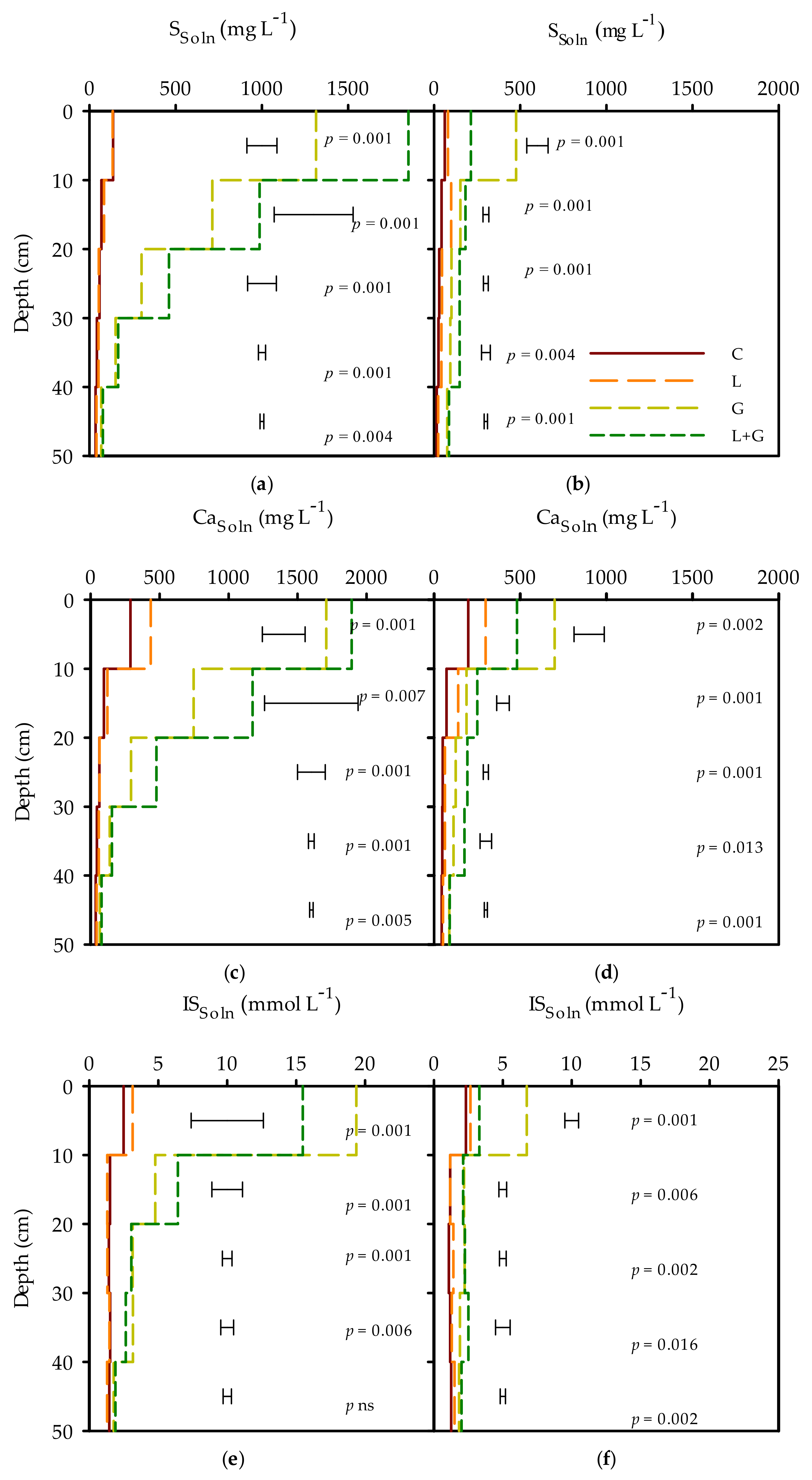
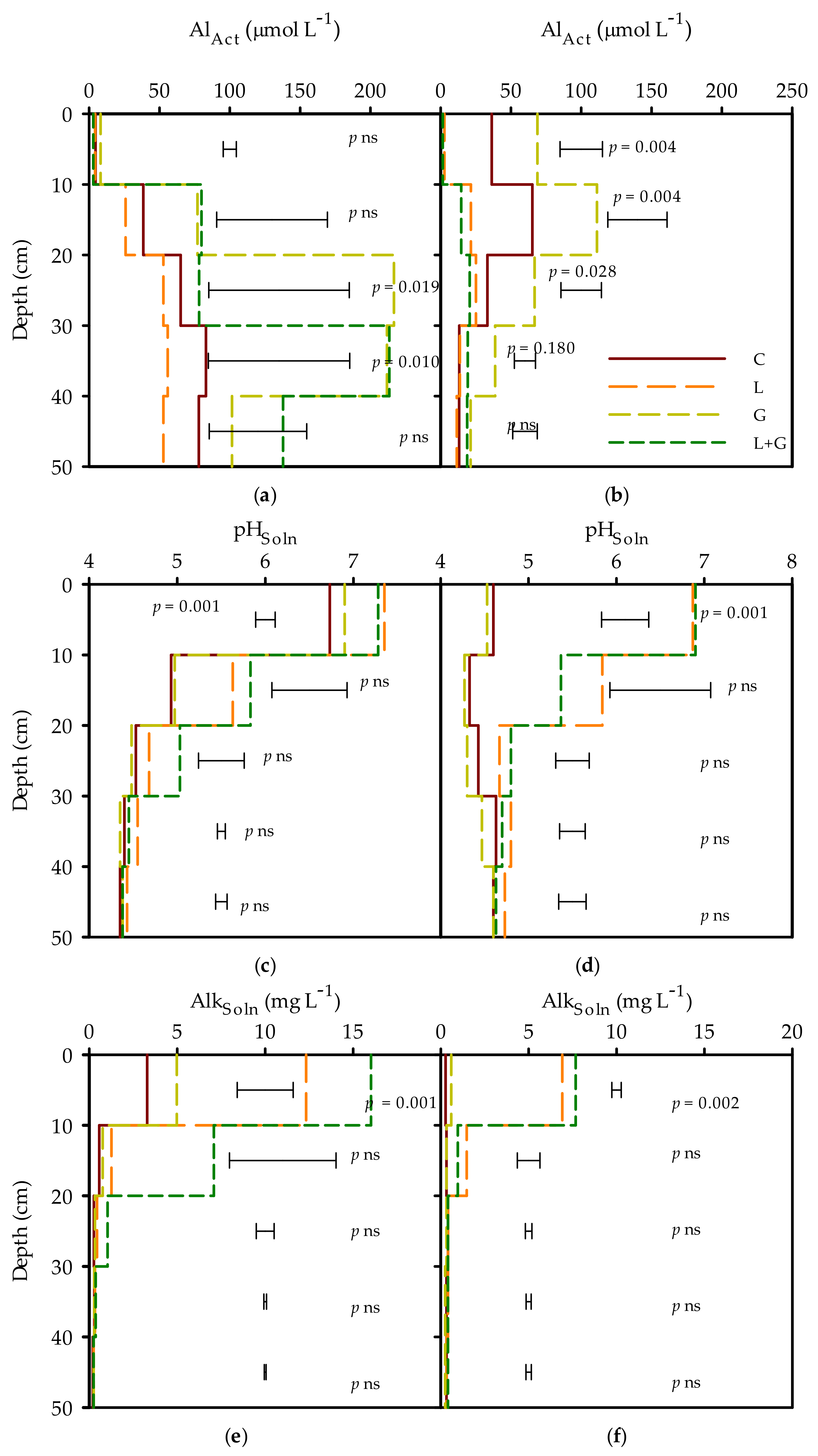
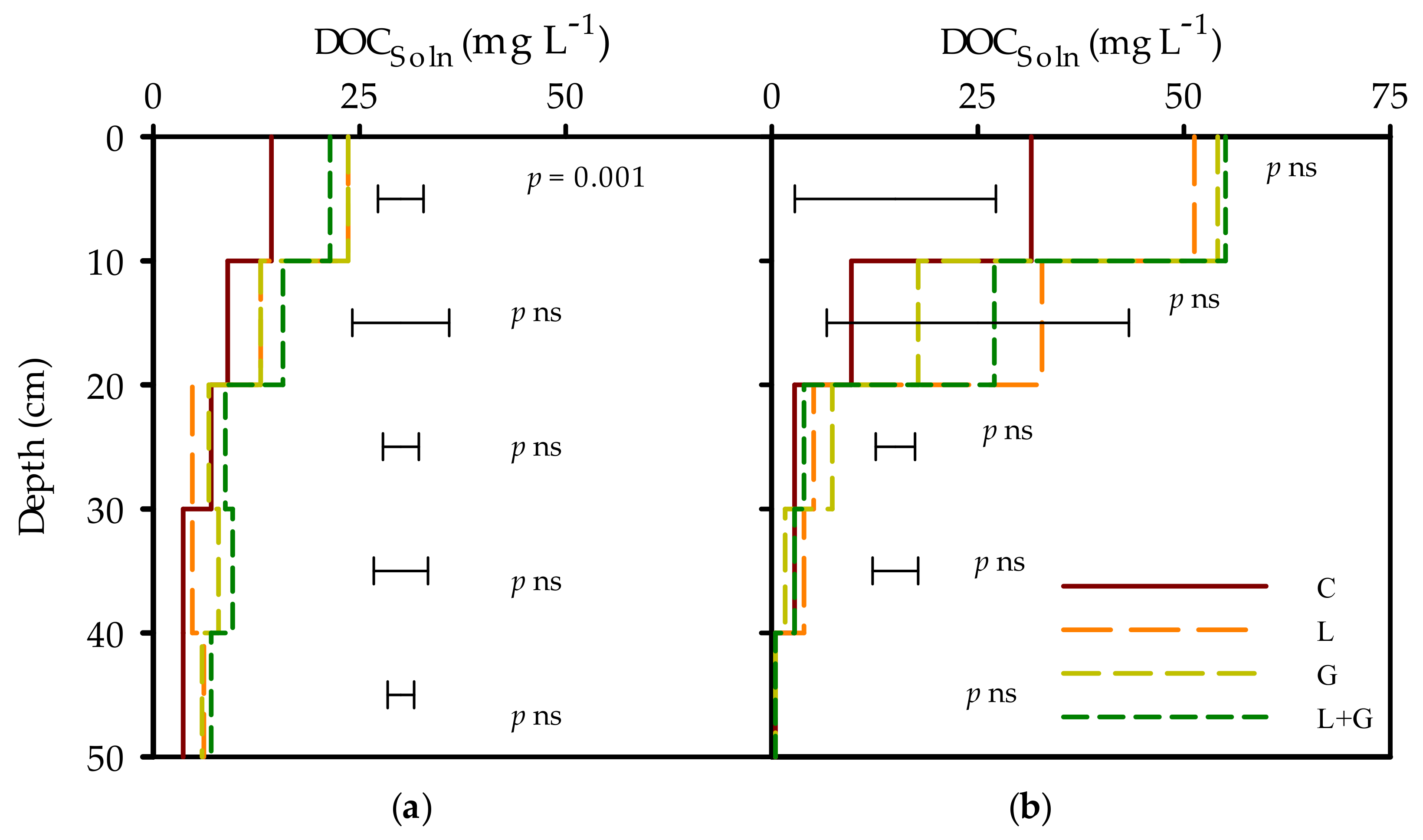

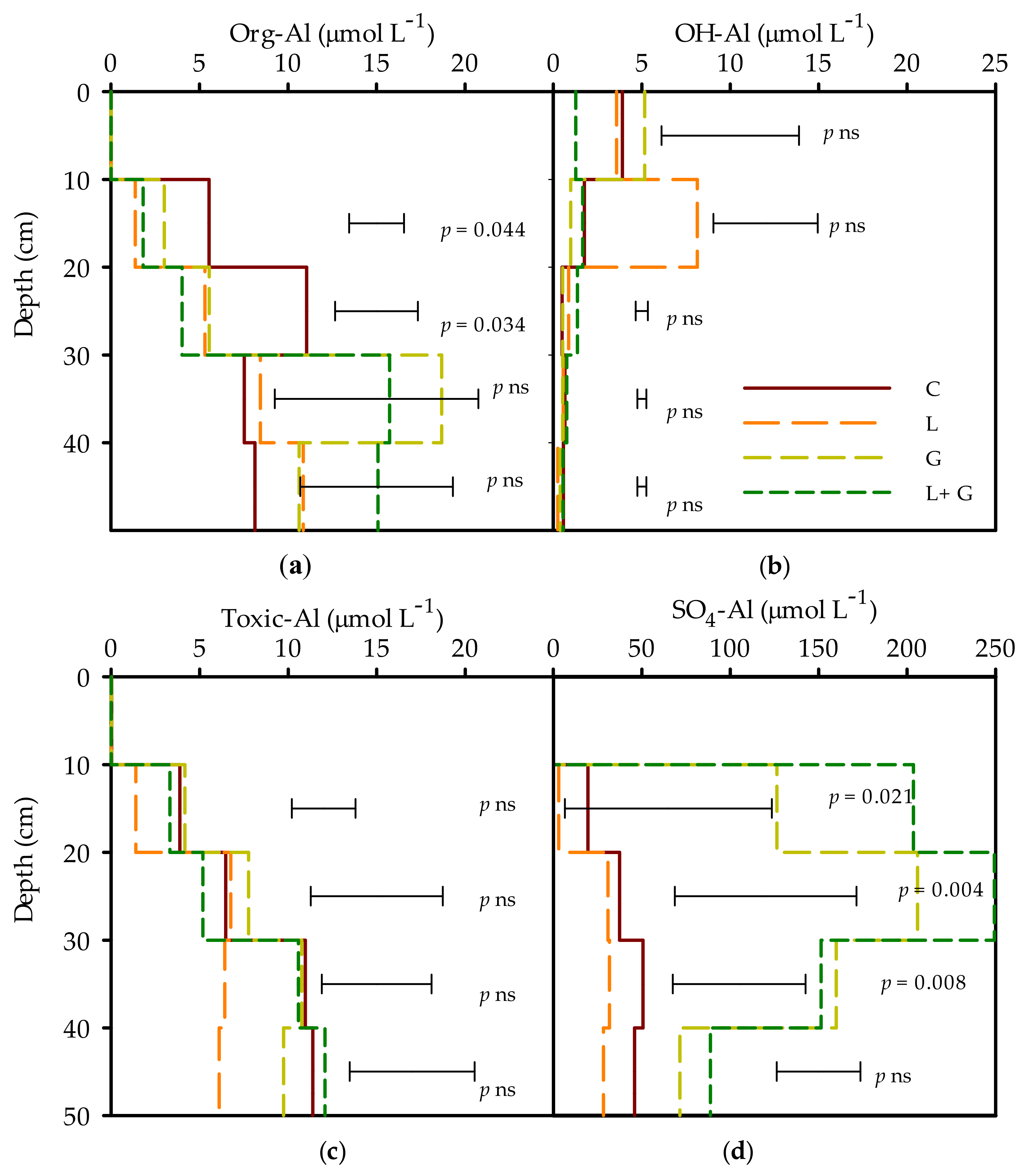
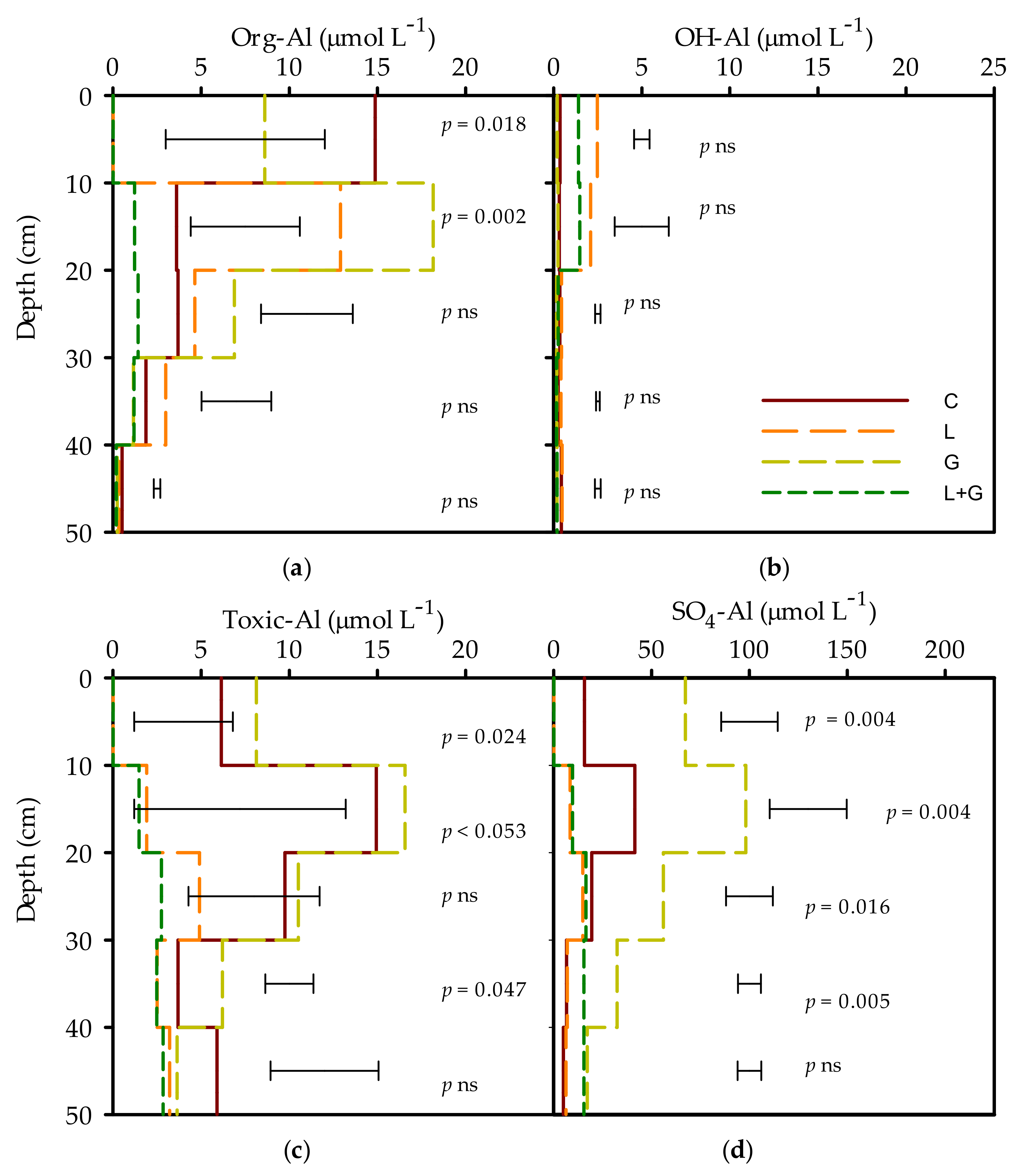
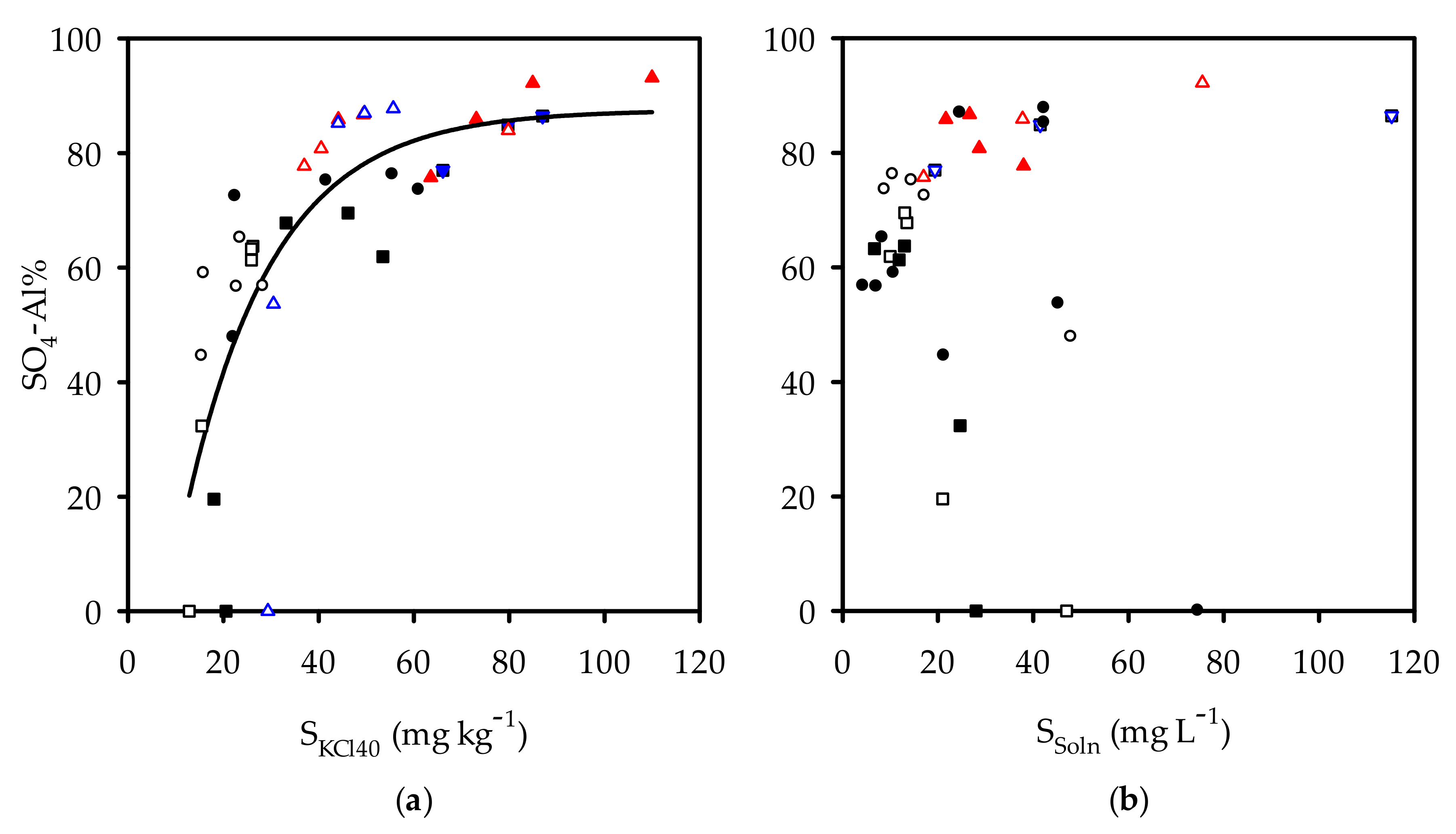
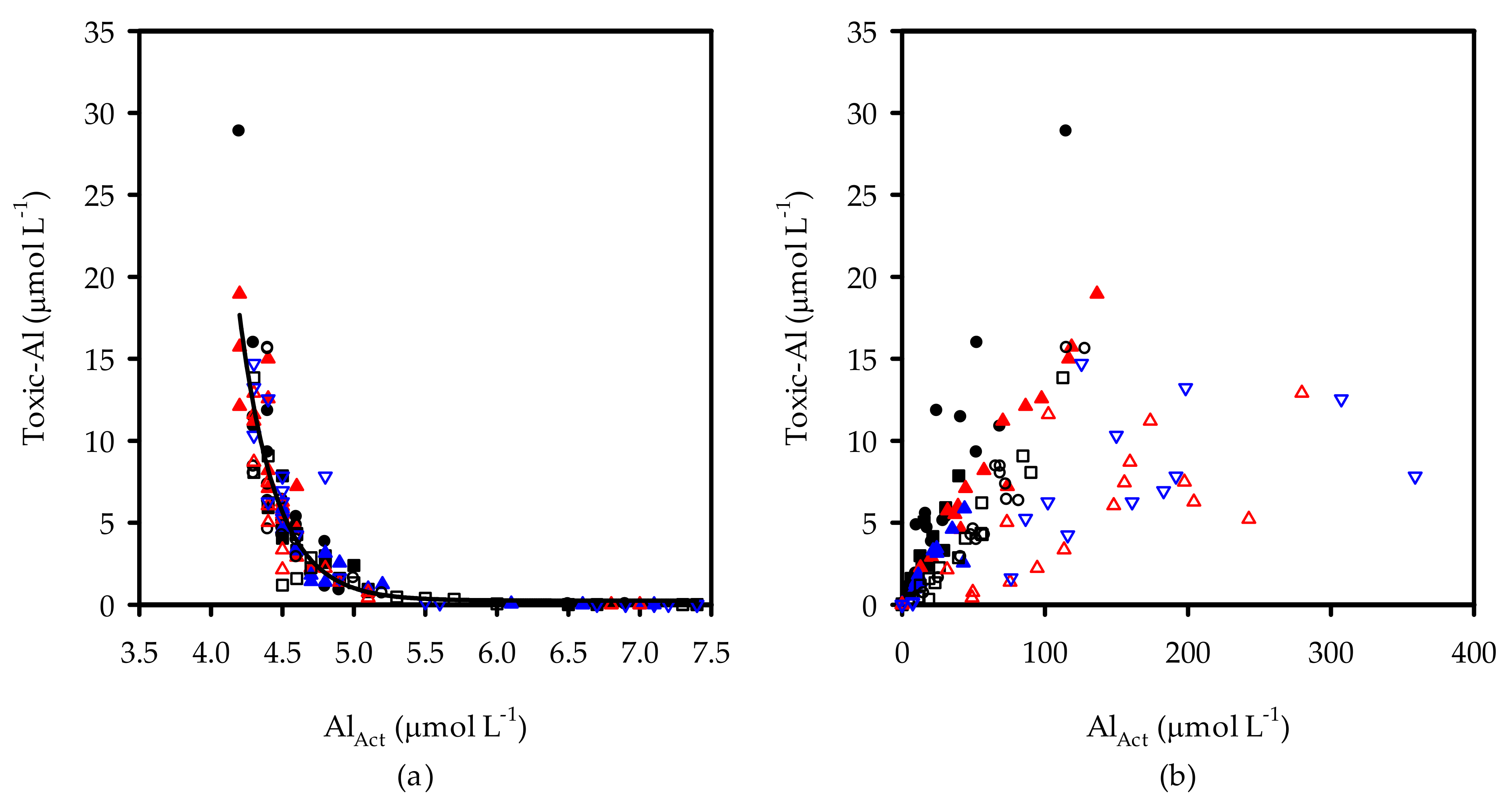
| Comparison | Period Time | Treatments | Relationship | Regression Coefficients | r2 | ||
|---|---|---|---|---|---|---|---|
| a | b | c | |||||
| pHCaCl2 vs. pHSoln | ST < | All | Linear | −2.07 | 1.54 | 0.83 | |
| SKCl40 vs. SO4-SSoln | ST < | All | Exponential | −48.6 | 1616 | 0.59 | |
| pHCaCl2 vs. AlAct | ST < | All | Exponential | 0.0001 | 56098362 | 0.0039 | 0.42 |
| AlCaCl2 vs. AlAct | ST < | C and L | Linear | 5.56 | 3.21 | −3.14 | 0.71 |
| AlEx vs. AlAct | ST < | C and L | Linear | −3.96 | 96.41 | 0.67 | |
| CaEx vs. CaSoln | ST < | C and L | Linear | 8.19 | 125.2 | 0.87 | |
Publisher’s Note: MDPI stays neutral with regard to jurisdictional claims in published maps and institutional affiliations. |
© 2021 by the authors. Licensee MDPI, Basel, Switzerland. This article is an open access article distributed under the terms and conditions of the Creative Commons Attribution (CC BY) license (https://creativecommons.org/licenses/by/4.0/).
Share and Cite
Anderson, G.C.; Pathan, S.; Hall, D.J.M.; Sharma, R.; Easton, J. Short- and Long-Term Effects of Lime and Gypsum Applications on Acid Soils in a Water-Limited Environment: 3. Soil Solution Chemistry. Agronomy 2021, 11, 826. https://doi.org/10.3390/agronomy11050826
Anderson GC, Pathan S, Hall DJM, Sharma R, Easton J. Short- and Long-Term Effects of Lime and Gypsum Applications on Acid Soils in a Water-Limited Environment: 3. Soil Solution Chemistry. Agronomy. 2021; 11(5):826. https://doi.org/10.3390/agronomy11050826
Chicago/Turabian StyleAnderson, Geoffrey C., Shahab Pathan, David J. M. Hall, Rajesh Sharma, and James Easton. 2021. "Short- and Long-Term Effects of Lime and Gypsum Applications on Acid Soils in a Water-Limited Environment: 3. Soil Solution Chemistry" Agronomy 11, no. 5: 826. https://doi.org/10.3390/agronomy11050826
APA StyleAnderson, G. C., Pathan, S., Hall, D. J. M., Sharma, R., & Easton, J. (2021). Short- and Long-Term Effects of Lime and Gypsum Applications on Acid Soils in a Water-Limited Environment: 3. Soil Solution Chemistry. Agronomy, 11(5), 826. https://doi.org/10.3390/agronomy11050826








